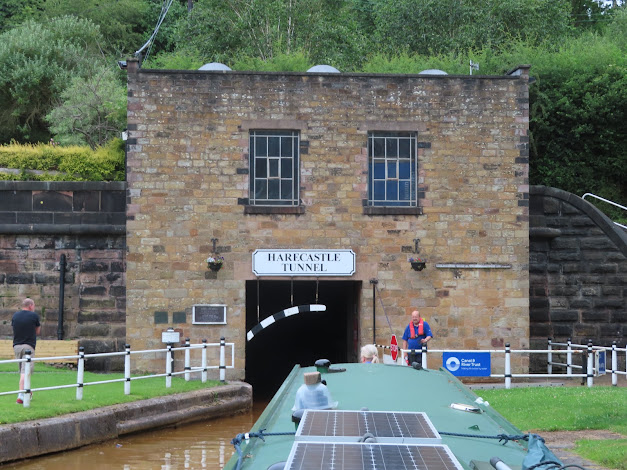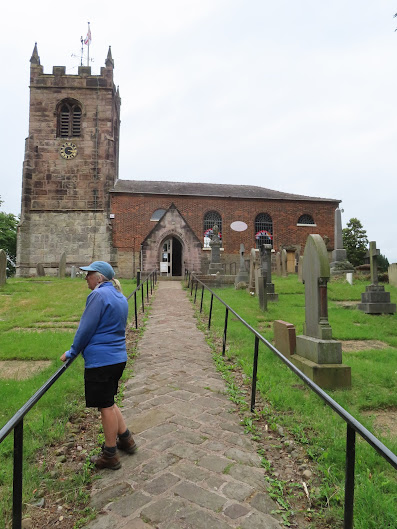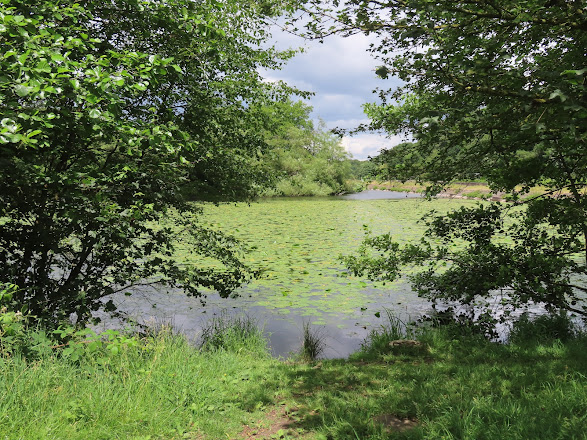We got off a little earlier than normal and as it turned out it worked out pretty well for us. We wanted to get to Wheelock before the forecast rain arrived.
It is a nicely rural stretch of canal and as we were going down hill Helen drove and I worked the locks.
Most of these Cheshire locks were doubled in the 1830's to help cope with delays due to the number of boats trying to use the locks. I'm not sure where this was but I think one of the Lawton Treble locks that were built by Telford to replace a staircase that ran to the east of the present line.
I would say that between a third and half of one of the duplicated locks at each set is out of commission. Not sure as repairing them is too expensive or that it is a convenient way of saving water. Probably both.
Along this stretch were loads of these orchids. I think they are chalk fragrant orchids, but maybe wrong.
We got to Rode Heath having past one or two boats and had all the locks with us, mostly with a bit of a top up. There was a sawmill before the locks, lime kilns and salt works bringing business to the town where many boaters lived ashore carrying relatively short trades.
The Pierpoint Locks are quite isolated. I don't think they were named for the old official hangman though.
The top lock of the Hassle Green Locks has a nice warehouse cum lock keepers cottage.
The M6 was flowing nicely today but what a din! We are well past the half way mark of our 20 locks today down the Cheshire Locks, or Heart Break Hill.
I spotted this brick by one lock. 'Sutton Oak Brick'. It is one of the many companies working the brick fields around St. Helen's and made all kinds of clay items.
Now down at Malkin's Bank and entering lock 62 we can see ahead a towpath over bridge of a short arm that once serviced the Brunner Mond Sodium Carbonate Chemical works. There was once another arm that led to a small dock. Behind us was the old Wheelock Salt works that also had two short arms to the works. Beyond the Brunner Mond works was the Whitehall Salt works, and this too had one arm.
We made it down to Wheelock in a good time, and it didn't rain until we were in and having lunch. We went and topped up with water and then backed down to the visitor moorings before the services. Opposite here would have been yet another salt works, but much quieter today. The rain didn't really amount to much, and no thunder and lightning as forecast, so we decided to walk up to Sandbach for the afternoon.
Rather than walk up the road we followed a path that ran beside the river Wheelock and cam at at the old Sandbach Corn Mill. It was built in the later 1800's and was powered by an overshot water wheel to grind corn. It is a nice quiet area now.
The nice square was reached after a series of roads and footpaths through some estates and past a Waitrose shop. The War memorial is different and sit in front of the Old Black Bear that was built in 1632
At the other end of the square were a couple of Saxon Crosses with some explanation of the carvings on them. It seems that the reliefs were once painted and the tops would have been topped with shiny metal ornamentation too.
It was starting to rain more steadily so we looked for our shopping list, a towel and some wool and then a trawl of the charity shops. We got both in one or other of them.I had just said to Helen that you hardly ever see towels in charity shops when I spotted some. The combined Town Hall and indoor Market were built in 1890 and were decorated just for our arrival.
I had spotted a Joules pub earlier and we decided to rest our weary legs for awhile and have a pint. The Lower Chequer is the oldest pub in town dating from 1570 when it was called the Church Inn. The parish church is just round the corner. We had a great chat with the land lady and friends, with a couple of pints. As they didn't do food they suggested that we should head to the Old Hall for sustenance.
A church and priest were recorded here in the Domesday Book but although fragments of old stone work are found the church was substantial reconstructed by Gilbert Scott in 1847-1849. The tower is a copy of the old one with it built on three side on arches with a public footpath under it. The church is St. Mary's and by coincidence in Hull St. Mary's also has a foot path through the arch below the tower.
The old Hall is the second oldest pub in Sandbach being built in 1656. The original building was built on the site of the old manor house and was enlarged in the 1700' and was then a coaching in as it sat on the Liverpool to Lichfield route. It later was championed as an hotel and extended a couple of times. It was occupied by US offices in WWII after which it resumed as an hotel until 2005 when it was closed and was left emty for several years and was grade A on the at risk register of being lost. In 2010 Brunning and Price bought it and restored it to life and opened it again in 2011, so saving this Grade 1 Listed building. I must say we had a lovely meal and not to expensive. They also had a good range of beers, sadly no stout.
We then walked back to the boat well satisfied with our adventure to parts new.




























































